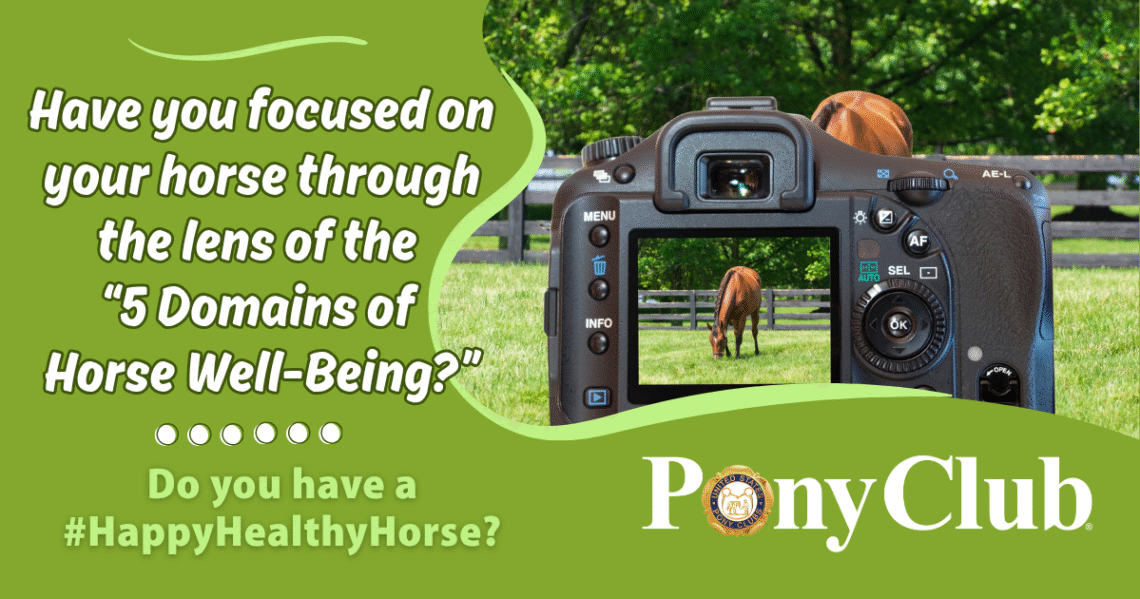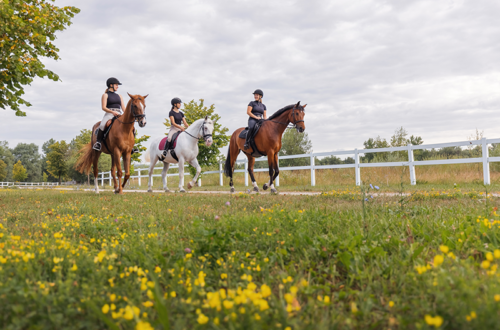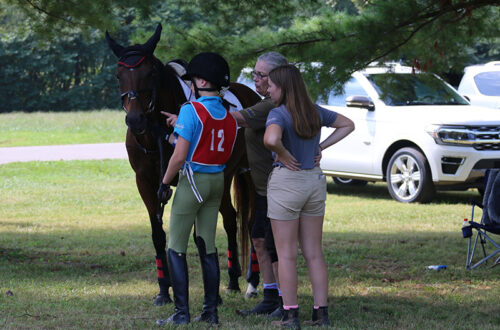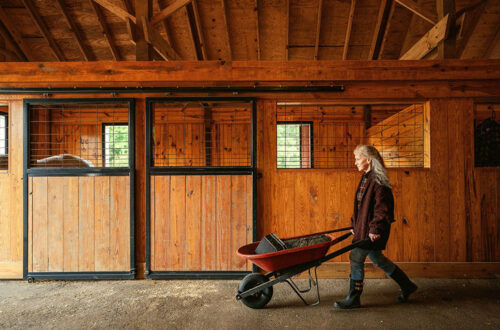
How Horse Well-Being is Embedded in the United States Pony Clubs Curriculum
By Stacy Anderson, DVM, PhD, Dipl. ACVS-LA; Member of the USPC Horse Welfare and Social License Task Force
The United States Pony Clubs (USPC or Pony Club) has long been recognized as the premier educator of young horse people, focusing on exemplary horse care and exceptional horse management. Aligning with other horse organizations to promote and ensure horse well-being within the USPC organization, a team of horse professionals, including two equine veterinarians, was established as the USPC Horse Welfare and Social License Task Force. One of the results of this task force was the development of a horse well-being framework to incorporate into the USPC community and, eventually, into USPC curriculum.
The horse well-being framework is based off the “five freedoms” that were described in 1965 by an accomplished zoologist, researcher, and professor, Frances William Rogers Brambell. The five freedoms are typically recognized by animal welfare groups as the foundational components of animal welfare. They include (in no particular order): freedom from hunger and thirst; freedom from discomfort; freedom from pain, injury, or disease; freedom from fear and distress; and freedom to express normal behaviors (for the species). The task force determined that the five freedoms are closely aligned with current horse care and management practices taught by USPC, though some additional content will need to be expanded, particularly in the area of equine behavior.

At the same time, USPC is able to promote the fact that horse well-being, though not specifically called out, is a cornerstone of its horse care and management curriculum. To highlight this fact, the task force distilled the five freedoms used as a foundation for all animals into five domains of horse well-being that closely align with existing USPC curriculum. The five domains are: nutrition, health, environment, behavior, and emotional state, with the Emotional State Domain having a direct link to the other four domains.
Over the course of this article, and the #HappyHealth Horse Well-Being Initiative, the five domains will be described and related to the existing USPC curriculum, wherever possible. For domains where new curriculum requires development, the USPC National Testing and Curriculum Committee is actively working to create content that will allow members to learn about the five domains of the USPC horse well-being framework with a future goal of incorporating horse well-being into the USPC Standards of Proficiency.
The Nutrition Domain
First, let’s explore the Nutrition Domain. The foundation of the Nutrition Domain revolves around the concept that feeding programs should mimic, as closely as possible, the horse’s natural state of obtaining food and water. This concept is well covered in the USPC curriculum. At a minimum, a horse’s diet should be forage-based and be fed “little and often” to mimic the horse’s natural state as a grazing animal that typically spends up to 18 hours in a 24-hour period grazing. Additionally, a horse should have ready access to a water source that is free from contamination, and his diet should be customized to his individual needs (e.g., feed more to hard keepers and less to easy keepers). These requirements sound familiar, don’t they? That’s because Pony Club members learn about these aspects of nutrition as early as the beginning (D) level.
The Health Domain
The next domain is the Health Domain. The veterinary knowledge covered in the USPC curriculum is exemplary—I can say that as an equine veterinarian and dean of a veterinary school. The Health Domain involves the ability to first monitor the health of the horse (e.g., recognize when he is sick) and then provide timely and appropriate veterinary care when a horse is unhealthy. This domain also involves the concept of providing preventive measures to maintain health and avoid disease through practices like vaccination, deworming, and proper dental care (teeth floating). These are core concepts that USPC extensively covers in its curriculum from the beginning to the advanced level (from D to A).
The Environment Domain
The Environment Domain includes the ability to provide the horse an environment that allows freedom from fear and distress. Much of this domain revolves around the fact that, as prey animals, horses have a honed flight response, and their environmental requirements are very different than most domestic animals.
At its foundation, a horse needs access to shelter to escape the elements. He also should have access to ground that is dry and allows him to sleep comfortably while laying down, even though he spends minimal time sleeping this way. In order to relieve the prey response, all horses should be housed in groups, if possible, so that they can have guardians during periods of recumbent sleep and due to their natural desire to be part of a herd. To protect the horse from his prey response, he requires safe fencing and space free from obstacles that he could injure himself on. Finally, to meet the needs of an animal designed to walk many miles in a day as a grazing animal, a horse requires the ability to move freely and exercise, ideally at his own discretion.
Again, many of these concepts should sound familiar to Pony Club members as they are core components of the USPC curriculum. The USPC curriculum addresses horse management from multiple aspects and includes farm management, barn management, pasture safety, and care of horses in different management systems and at different life stages. Those foundational curricular concepts just need to be linked directly to the impact on horse well-being.
The Behavior Domain
The next domain, Behavior, has some content in the USPC curriculum but needs to be expanded to adequately address the concepts of horse well-being. Research on equine behavior is expanding rapidly, particularly in areas such as the effects of equipment and training practices. At its foundation, equine behavior must be understood within the context of the horse’s natural state. Horses are prey animals and should be handled and trained in ways that respect this nature—working with their instincts rather than against them—to develop a willing partner.
Horses are also herd animals, which means they are rely on the company of others and aren’t meant to live alone. In their natural environment, horses roam freely over larger areas, so they naturally need some sense of freedom and the ability to make choices for themselves. The USPC curriculum covers inappropriate horse behavior, or vices, but more content needs to be developed for members to better understand normal horse behavior and how we can all foster healthy behavior in our equine partners.
The Emotional State Domain
The Emotional State Domain refers to the horse having a positive mental state. All other domains ultimately contribute to this final domain. A horse cannot have a positive mental state if his basic natural needs are not met and he is not able to exist as he should. Through domestication, horses have been removed from their natural state, yet they have demonstrated remarkable adaptability. However, the closer horse management practices align with their natural state, the greater their potential for achieving optimal well-being. While the concept of horse well-being is understood within the USPC curriculum, it is important to highlight this critical domain and improve member awareness while USPC continues to develop intentional curriculum to identify, describe, and improve horse well-being.
In conclusion, the USPC has built a robust curriculum that teaches members about horse care and management, covering many aspects of equine well-being. There is a tremendous opportunity to highlight USPC as a leader in promoting horse well-being and to expand its influence across the horse industry. Now is the time to ensure that the Pony Club community’s values put horse well-being first—making it visible in everything we do.
Here’s to your happy, health horse! May you and him succeed in all five domains.
Stay tuned for regular articles and resources on the Happy, Health Horse Well-Being Initiative.





